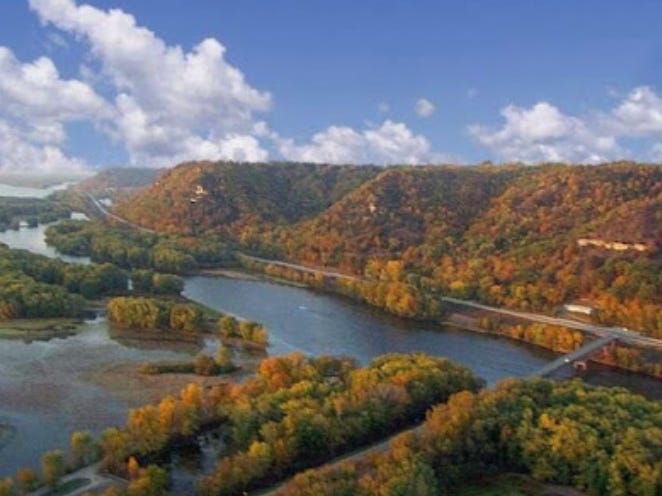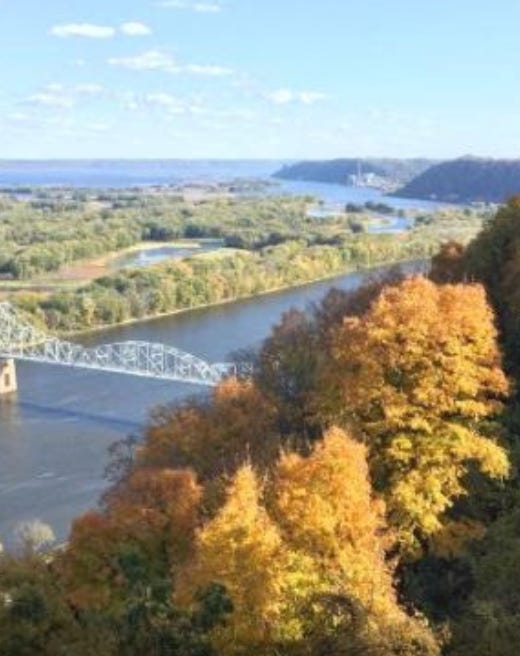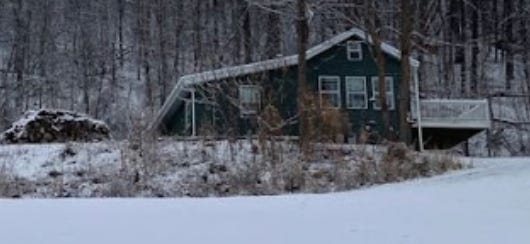It was a year ago now that a couple of farmer-legislators decided they didn’t like my work at the University of Iowa, and intervened accordingly. I wanted to write one last piece for my university blog to provide some closure to regular readers, and the piece that follows was the result. While writing it, I decided it might be best for everyone involved that I retire.
I considered the possibility that this piece might be the last I would write for a public audience. My book was six weeks from being published and while I was happy to end my career publishing a book, my expectations for it were modest at best. I was vaguely aware of Substack, and I knew very little about it. Bob Leonard encouraged me to pursue it and provided advice.
I still think that piece of a year ago is one of my better pieces of writing. Elements of it were used in a piece that was published in Izaak Walton League’s national magazine, Outdoor America. The Story of Chief Blackhawk’s defeat, central to the essay, is one of the saddest things about Iowa. Although the final battles occurred in what is now Wisconsin, the outcome opened up Iowa to a flood of people of European descent.
Note on the The Blackhawk Bridge mentioned in the essay: It was recently damaged during construction of its replacement bridge, severing one of only two connections between Wisconsin and Iowa north of Dubuque. A ferry service has been set up to provide transportation for people between Lansing, Iowa and De Soto and Ferryville, Wisconsin, for at least the next two months.
Arguably the most beautiful part of Iowa is the 100-mile-long sliver of bluff land that lies along the Mississippi River from Bellevue to the Minnesota border. The northernmost part of this river corridor is also where Sauk Chief Blackhawk was defeated in 1832, opening the state to white settlement. Blackhawk's people had wandered across the river into what is now Wisconsin, violating a treaty they misunderstood, to access their traditional summering ground. U.S. troops drove women and children of Blackhawk’s tribe into the Mississippi where they drowned just north of what is now Lansing, Iowa.
Blackhawk died six years later and was buried in a grave overlooking the Des Moines River in southeast Iowa. His corpse was stolen shortly after, however, and the flesh boiled off so his skeleton could be exhibited. His remains were eventually moved to a Burlington, Iowa historical society at the request of territorial Governor Robert Lucas, where they were later lost in a fire. After the fire, a memorial to Blackhawk was constructed in the Iowaville Cemetery near Selma, Iowa. Governor Lucas’ Iowa City home, known as Plum Grove, is maintained as a historical site and he is buried in Oakland Cemetery in Iowa City. Lucas Street runs north to south on east side of town.
Winnebago Chief Winneshiek (Coming Thunder) was an advisor and confidante of Blackhawk whose people occupied areas of northeast Iowa and southwest Wisconsin, and they were known to have encampments along the Upper Iowa River. Winneshiek was asked to side with U.S. troops in the Blackhawk War; he refused. The tiny Mississippi River village of DeSoto, Wisconsin is thought to have been built upon the burial ground of Winneshiek’s tribe, and Winneshiek himself is rumored to have been buried on the bluff that overlooks the village, aptly named Mount Winneshiek.
The names of Winneshiek and Blackhawk are familiar to Iowans mainly because they were attached to two of our counties. Numerous places, schools, sports teams, military weapons, and even a community college and a country club bear the Blackhawk name. Blackhawk helicopters have been used by the U.S. Army since 1979 and a book and a movie were named after one that was shot down. The iconic Blackhawk bridge, made famous by the movie The Straight Story, is one of a series of four bridges that span the Mississippi between Lansing (IA) and DeSoto (WI); one of the other three is named for Winneshiek. The Mississippi River sloughs around both towns are known as the Winneshiek Bottoms, now a National Wildlife Refuge that was saved (barely) from agriculture’s insatiable appetite for land by the 2-year-old Izaak Walton League in 1924. There have been multiple failed attempts to turn the area into a national park.
I think a lot these days how these events are relevant to my own life. My ancestors were among those that poured into an Iowa made ‘open’ by Blackhawk’s defeat. They farmed in Des Moines, Davis, and Wapello (another Native American chief) Counties in southeast Iowa, and Warren County in south central Iowa. My uncle had a museum quality collection of Native American artifacts unearthed by his uncle’s plow in Davis County. I sometimes wonder if fate might have had me farming now, had my ancestors been better at it. My Iowa City home was in the same neighborhood as Governor Lucas’; I sold it to buy an old Amish cabin on the edge of DeSoto, WI, although I’m still pretty much anchored in Iowa City.

I often hear farmers proudly boast that they are the 5th or 6th or Nth generation of their family to earn a living off their patch of Iowa. “Never sell the home section” is a deathbed command made by many to their heirs across the generations, a concept foreign to the peoples of Blackhawk and Winneshiek. I too am a 5th or 6th generation Iowan and see my rights as a non-farming citizen as being no different from those that farm. And whether your genes have been here for two hours or two centuries, I think your right to enjoy nature, and especially, clean water, should not be debased by the fact that you’re surrounded by farmable land. It’s not uncommon to hear some variation of “we’re a farm state, get used to it.” I reject that. And I think if the state is to have a prosperous future, it needs to be rejected by the masses. That rejection has been out in front of every essay that I have posted here.
I can sit in my humble little cabin and see the Iowa bluffs and the Blackhawk Bridge from seven miles away, the latter especially at night when it is decoratively lit. I wish I could put into words the irony I feel in being able to look up from typing this and see Iowa from afar. If you’ve never seen the Blackhawk Bridge, I suggest you plan a trip to Lansing because it will soon be gone and replaced with something better.
You’re reading the last one of these essays that will be posted here at the university domain. I’ve got some things to think about, one being a continuation of the blog on another site. Whether I write new pieces for another site, I just don't know. My mind changes by the hour on this. If I return to writing essays, they may be different from what I have written here in noticeable ways, either in tone, subject matter or both. It's undeniable that the essays' presence on the university domain imparted a 'fearlessness' character to the pieces that added to their appeal and maybe caused some to judge the writing as better (or worse) than what it really is. This is something for me to consider. I’d like to try some different things when it comes to writing, but I don't know if I'd be good at writing about much else. I was asked to write the obituary for my uncle mentioned here in this essay, and that follows. So call that one "Make Obituaries Great Again," I suppose. The pieces posted here (meaning on the University domain) have been read 200,000 times in total, and because of that, good fortune is among the feelings that I have right now. Thank you for reading. I hope I helped you learn something.
Paul Wagner Obituary
Paul Wagner may have been a moderate man of moderate words, but his zest for existence and awe of the creation were nothing short of intense. He lived his life without regret like the creatures he loved: the fish of the deep, the birds of the air, the big mammals of the mountainsides, and especially, his loyal canine companions. Paul drank it all in and it was all the better for him when accompanied by his loved ones – son Jeff, grandson Alex, and wife Taminie and his good friends.
Paul was an accomplished machinist, a self-trained engineer and mechanic, a craftsman, and maybe above all, a tremendous artist. His creations were forged from the earth itself: metal, rock and wood configured for both beauty and utility. There can be no doubt that his artwork was a translation of the majesty he saw from the mountaintops, the rapids, the plains, and the forests. He also had an artist’s discerning eye for those that shared his perspectives but translated them in different but equally beautiful and moving ways, and these other works were displayed close to his own, each enhancing the other. This included the work of the ancients, gathered from his uncle’s Iowa farm displayed next to his, a reminder to us of the human appreciation of craftsmanship and artistic continuity that spans the centuries.
Paul’s active mind could find comfort in the simplicity of his everyday tastes and habits, but also in the complexity of machines and the natural world. His thoughts and ideas conformed to no single person or ideology, and you knew within minutes of meeting him that he was a genuine and honest man.
Paul Edwin Wagner entered this world on August 31, 1943, in Knoxville, Iowa, the son of Ivah and Roscoe Wagner. As a youth, Paul loved the outdoors and its pursuits, card playing, cars and working on them, and the Knoxville car races. He attended Knoxville High School, where he was a member of the golf team, and graduated in 1961. He then took coursework at Iowa State University before accepting a job as a machinist at John Deere Des Moines Works in Ankeny. Following an exemplary career, Paul retired in 1994, and after sorting things out for a couple of years, moved from Iowa to Dubois and then Cody, Wyoming where he pursued his avocations of communing with the animal kingdom and the grandeur of the Rocky Mountains. It was here that his skills as a craftsman and artist saw their true expression, and where the height of his humanity was reached. Paul’s last few years were spent in his native Central Iowa where he wore out the pavement walking his beloved dogs.
A wiry and rugged man, the years were no match for his body, which retained its 1965 character to the end. Defeated, the years came for his mind and ultimately won a tenacious battle with him on December 31, 2022. Paul is survived by his wife, partner and fellow traveler these past many decades, Taminie; his son Jeff and wife Angela of Dallas, Texas; grandson Alex Wagner of Driggs, Idaho; sister Maxine Jones of Ankeny; and Taminie’s children Myles Curnes of Des Moines and Katie Ramos of Ventura, California. Paul’s remains will spend eternity among the volcanic rocks and snow-capped Carter Mountains at Fenton Pass, Wyoming.
I’m a member of the Iowa Writers Collaborative. There are some great writers (shown in the list below) and some big names in that group. They’re all posting here because like me, they want Iowa to be a better place to live, and words are our tools.








Beautiful. Powerful. And a grand obituary. We are all glad that you have continued your writing here.
We need to heed the words of deep thinkers like you. It is not enough to love the outdoors, as many do. We need to honor and nurture it.
Thanks once again, Chris, for weaving a bridge to our past and resetting our compass. Now we must engage all navigators (legislators) in a proper direction.